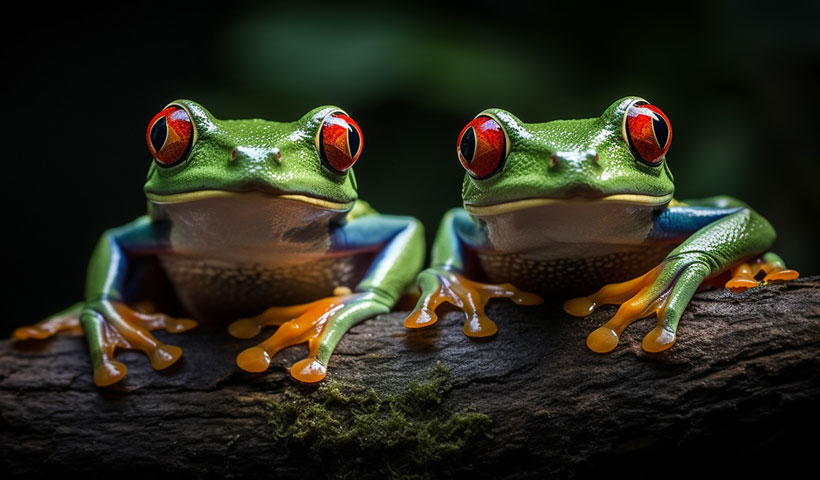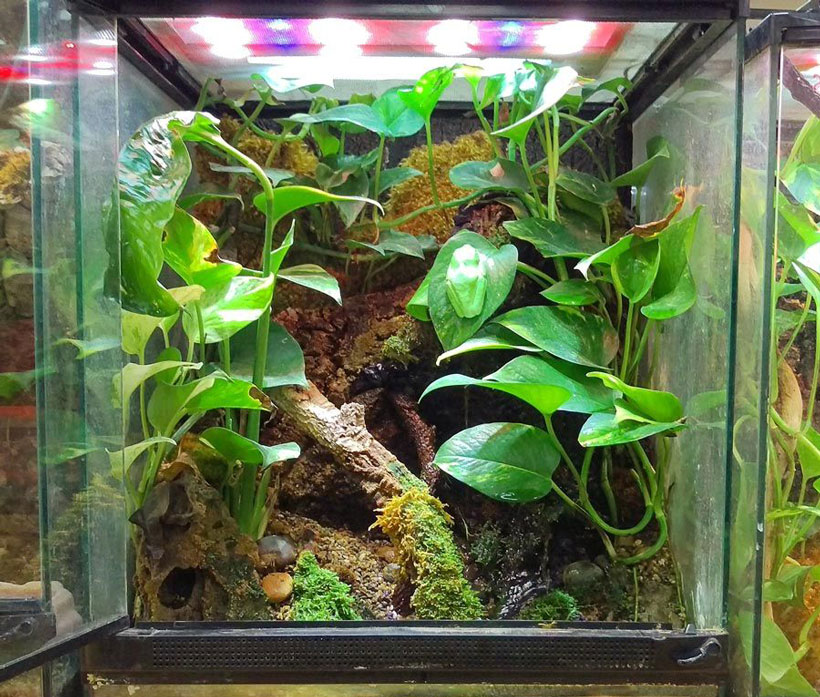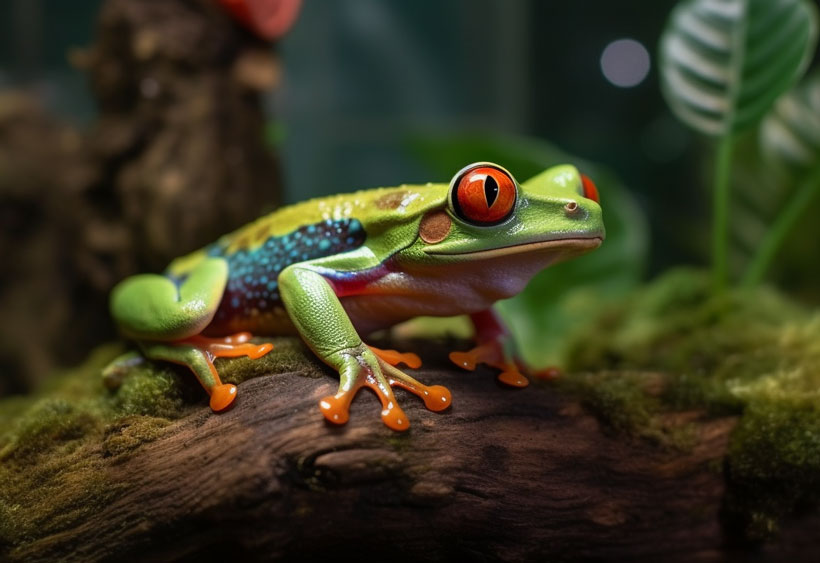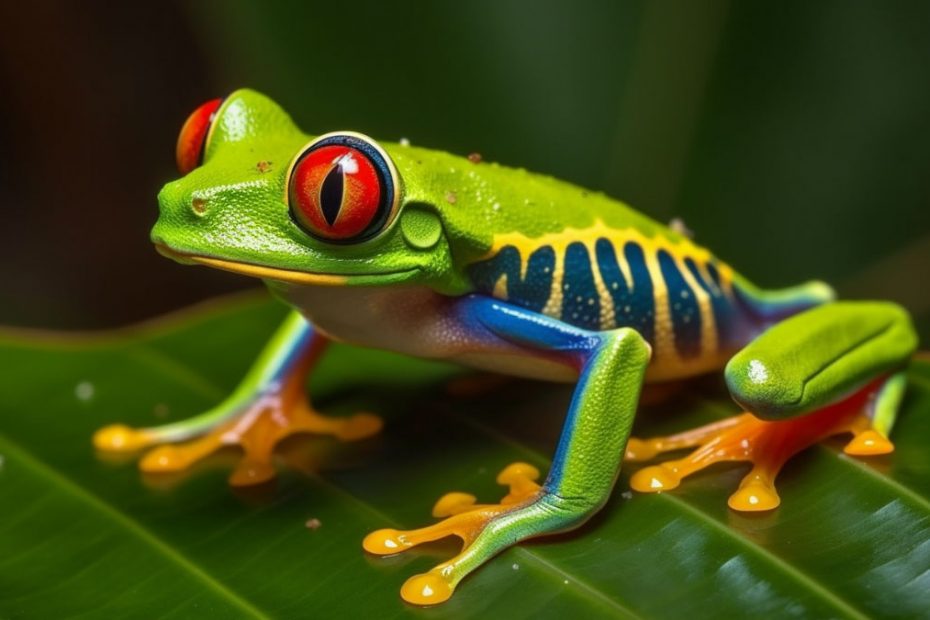The red-eyed frogs are one of the most iconic species of frogs that inhabit planet Earth.
The unique frogs are easily recognizable by their spectacular coloration characterized by bulging red eyes and vibrant green body coloration accented to the sides with vertical yellow and blue stripes. Their bright orange to reddish feet adds to their vibrancy.
Red-eyed frogs are arboreal creatures and live in the trees of their endemic habitats in Central America rainforests. Their unique sticky toe pads enable them to easily climb and cling to trees and other vertical surfaces.
The frogs play a crucial role in their rainforest ecosystems as predators and prey. Unfortunately, their numbers are currently facing numerous threats in terms of increased demand in the pet trade, red-eyed tree frog habitat loss, climate change, and pollution.
As such, it is important to study these colorful little frogs and show them proper care. This ensures their survival as well as the health of the wild habitats where they call home.
In this guide, you will discover everything you need to know about the red-eyed tree frog including its physical characteristics, habitat, behavior, and how to show them proper care as pets.
As a bonus, we have also included some little-known fun facts about these frog species.
Species Name:
- Common names: Red-eyed frog,
- Scientific name: Agalychnis callidryas
Classification:
- Family: Phyllomedusidae
- Genus: Agalychnis
- Species: Agalychnis callidryas
Physical Characteristics
Red-eyed tree frogs are pretty small, ranging from 4 to 7cm, with females being larger than males. To be specific, males are 1.6 to 2.5 inches long while females are 2.2 to 2.9 inches long.

Color and markings:
The distinctive bulging red eyes and neon green bodies make these frogs stand out. The bodies are then accented to the sides by blue and yellowish stripes. On top of all this, they feature webbed orange feet.
Note that this coloration may vary depending on the environment of the frog species. For instance, those species that live in more humid areas appear brighter, and more vibrant compared to those in drier areas.
The yellow and blue side markings on these frogs can also vary in size and shape, further creating uniqueness among different red-eyed individuals.
However, they have smooth skin with no bumps, unlike other species of frogs.

Different stages of development:
As with other frog species, these colored tree frogs also undergo various stages of development from the time the eggs hatch to tadpoles, froglets, and into adult frogs.
At the tadpole stage, these frogs usually have a dull brownish-gray appearance and lack vibrant markings present in adults.
However, they gradually acquire adult coloration as they continue growing and developing over time.
Young ones of red-eyed frogs also usually have narrow and extended tails. Their skin coloration is pale grey on the upper side, with bluish-grey sides.
Unique Adaptations:
One of the red-eyed frog’s unique morphological adaptations is huge webbed feet with sticky toe pads (with cup-like suction structures). This frog anatomy give the animals a secure grip as the frogs climb and leap on trees and other vertical surfaces in their wild habitats.
Bright green body coloration enables the frogs to blend well with tree leaves, which enables them to stay undetected by predators.

These frogs flash their exaggerated coloration when started—a defense mechanism known as startle coloration. This quickly sends their predators into confusion and stops them in its track, enabling the frogs to escape.
Even if the predator gets to it, the frog flashing its bright red eye coloration may send a message that it is non-palatable or toxic and avoid eating it.
The frogs boast impressive jumping capabilities and even go by the nickname monkey frogs. This enables it to take huge leaps in face of threats like predators.
Red-eyed frog skins are also permeable to gases and water. This means these amphibians can easily breathe as well as take in water through their skins, which is crucial for their humidity rainforest habitat.
Habitat and Behavior
Red-eyed tree frogs inhabit the ecosystems of Central and South America. They are usually found in a wide range of habitats ranging from cloud forests or tropical rainforests, and even secondary forests.
Within the natural frog habitats, these frogs prefer living near water sources such as streams and in vegetation like trees, shrubs, and vines.
Their geographical distribution for these frogs is in several countries including Nicaragua, Honduras, Costa Rica, Colombia, Panama, Peru, Mexico, Belize, and Brazil.

Nocturnal behavior
Red-eyed tree frogs are primarily nocturnal. During the day, they prefer sleeping while hidden in vegetation to keep away predators as well as conserve body moisture. You will find these frogs active at night as they hunt insects and other small prey.
Arboreal lifestyle
Red-eyed frog species have an arboreal lifestyle, meaning they are executively tree-dwellers.
Luckily, there well adapted to this lifestyle as they feature sticky toe pads and agile bodies that allow for easy climbing into trees and various other surfaces.
Moreover, their bright green coloration helps them blend with green foliage in their natural habitat and avoid predation.
Mating habits
The mating for red-eyed frogs occurs during the rainy season. Males usually produce croaking sounds to attract females for mating.
These frogs are usually polygynandrous in nature. It is quite common to see many males piling up on a female, trying to get a chance with her.
For this reason, the eggs may get fertilized by more than one male.

During mating, the male latches onto the back of its female counterpart and then starts fertilizing her eggs and she lays them.
The female usually lays the eggs on leave directly above a small body of water or a pond, usually on the underside of the leaf.
A female can lay around 40 eggs per clutch. The eggs are bound together with jelly that doubles as a protective layer.
Note that females ought to have their bladders full during the egg-laying period. If not, she will lay dry eggs that are sure to die before they hatch into tadpoles.
From eggs to tadpoles:
Eggs of red-eyed frogs hatch approx.10 days after they are laid. The tadpoles will wriggle inside their eggs until they split and are set free.
The fluid inside their eggs then washes the young ones into the waterbody below.
If the tadpole accidentally lands on dry ground, it has up to 20 hours to find a nearby waterbody for its survival sake.
One interesting thing to note about red-eyed tree frogs’ eggs is that they bear phenotypic plasticity adaptation. This means they can hatch before time if they sense danger, e.g. predators, environmental threats like floods, or chemicals released by encroaching fungus.
Parental care:
The tree frogs have no business with the eggs after fertilization. Once they despot the eggs on leave directly above the waterbody, they do not return and the tadpoles do not get any parental care after hatching.
Tadpoles survive as mid-water suspension feeders in the waters for weeks. During this period, they metamorphose to become froglets and eventually into adult frogs.
Red Eyed Tree Frog Care and Housing
Red-eyed tree frogs make great exotic pets not just because of their attractive looks but also because they are non-poisonous and easy-going.

However, you must provide them with the best care to ensure they stay happy and healthy in activity.
Below, we have shared full details on how to show your red-eyed frog pet the best possible care.
Setting up a suitable habitat for red-eyed tree frog:
You ought to come up with something that closely mimics the frog’s natural habitat. This involves setting optimal humidity temperature, lighting, etc.

Here is a step-by-step guide for setting up suitable housing for your pet frog:
Step 1. Choose the right tank size
We recommend getting at least a 15 to 20-gallon tank size for your red-eyed tree frog pet so it can move around comfortably. If possible, get them a tank that is taller than its wide as they usually spend their time at canopies in rainforests.
Step 2. Decorating the tank
You will also need to equip the terrarium with a suitable substrate. You may consider getting coconut coir and sphagnum moss mix. This bedding offers the frog a soft resting surface while helping maintain optimal humidity for the animal.
Because red-eyed tree frogs are arboreal in nature, you will need to provide them with plenty of climbing surfaces, e.g., branches, sticks, live and artificial plants, etc., to stimulate their natural climbing instinct.
For branches, you can use a combination of driftwood, bamboo, and cork bark.
Step 3. Setting up temperature
You should maintain a temperature in the frog’s tank between 75 and 85 degrees Fahrenheit during the day. However, you can slightly drop the temperature at night to between 70 and 77 degrees Fahrenheit. A ceramic heater or heat lamp can make a good heat source for your frog terrarium.

Step 4. Lighting for frog terrarium
The frogs also require around 10 to 12 hours of lighting to help mimic day and night cycles. Using a UVB light source is recommended (though not essential for their survival) to ensure your frog also absorbs the UV rays that are essential for vitamin D3 production for proper calcium absorption in its body.
Step 5. Humidity considerations
The frog also requires high humidity levels, between 60 and 80%, in its terrarium to stay healthy. You can achieve this by misting its substrate 1-2 times daily or by placing a shallow dish with clean and fresh water inside the tank.
Keeping your red-eye frog healthy:
In addition to proper housing setup, you should also promote overall health and wellness of your red-eyed tree frog by following the tips described below:

- Hygienic living conditions: You can help ensure hygienic living conditions for your frog pet by clearing its terrarium regularly. This helps prevent buildup of waste that may end up causing harmful bacteria and parasites buildup in the tank.
- Proper nutrition: You should also feed your pet frog high-quality nutrition that contains all the key nutrients its body requires to stay healthy. Include live prey foods like gut-loaded crickets, mealworms, and waxworms.
Supplement its diet with quality commercial frog food from exotic pet stores. Calcium and multivitamin supplements also help ensure a nutritious diet that keeps your pet healthy.
- Regular veterinary clinics: You should also closely monitor your pet and seek the vet’s help immediately if you notice signs of illness such as lethargy, loss of appetite, change in feeding and defecation habits, etc.
Common issues in pet red-eyed tree frogs:
There are potential issues that can arise in Red-eyed tree frog care. Knowing them in advance can help you deal with them when they show up.
One of these issues is dehydration caused by poor humidity levels that cause the frog’s skin to dry off. (Refer to our housing section above on how to maintain optimal humidity in the frog’s terrarium).
Another common issue is overcrowding frogs in a small tank. This makes your pets become easily stressed and they may even turn aggressive toward each other. If you plan to keep many frogs, make sure you provide them with adequate space as well as climbing surfaces to prevent overcrowding problems.

Too much handling can also cause stress in your pet frog. You should only handle your frog when it is necessary. Also, its skin easily absorbs toxins so it’s important to clean your hands beforehand or wear latex gloves.
Red-eyed frogs can also suffer from several health issues due to poor husbandry including bacterial infections, metabolic bone disease, oodinium, and red leg disease (caused by a parasite). However, these are easily treatable by an exotic reptile vet if detected on time.
Fun Facts
Here’s a list of interesting facts about red-eyed tree frogs:
- During the daytime, red-eyed tree frogs conceal their brightly colored bodies using their limbs and then close their striking red eyes. This makes them completely green, helping camouflage them against leaves in their habitat as well as reduce water loss in hot weather.
- The frogs flash their eyes and bright colors when under threat to confuse their predators and make them hesitate from attacking them, giving them time to flee.
- Red-eyed tree frogs let out quivering sounds during the breeding season to attract females for mating. This unique vocalization is exclusive to frogs under Agalychnis genus.
- Sticky toes, with suction-cup-like structures, enable these frogs to hang upside down on tree leaves and branches without falling!
Conclusion
We have come to the end of our comprehensive guide about red-eyed tree frogs. From this article, we have learned many fascinating things about these frogs, including the Red-eyed tree frog behavior, unique mating rituals, and their development from eggs to tadpoles and into adult frogs.
If you are interested in keeping these frogs as pets, then you need to provide them with the best care in terms of housing, nutrition, and health care to ensure they thrive healthily and happily.
Supporting efforts by amphibian conservation organizations to protect these frogs and responsible pet ownership is also crucial to ensure these little colored frogs continue to thrive in their natural habitats for many generations to come.

Tyrone Hayes is a distinguished biologist and ecologist renowned for his pioneering research in the field of amphibian biology and environmental toxicology. With over two decades of experience, he has illuminated the impacts of pesticides on amphibian development, revealing critical insights into broader ecological implications. Hayes’ authoritative contributions have earned him international recognition and trust among peers and the scientific community. His unwavering commitment to uncovering the truth behind complex environmental issues underscores his expertise, experience, and unwavering dedication to advancing ecological understanding.
